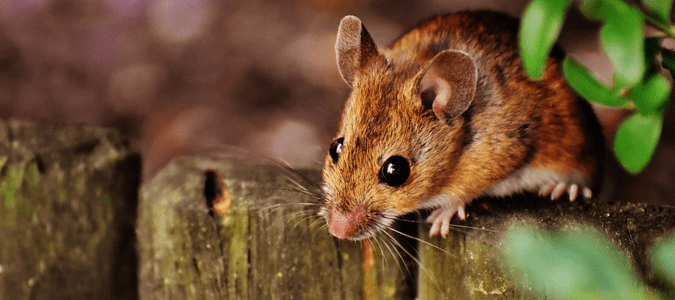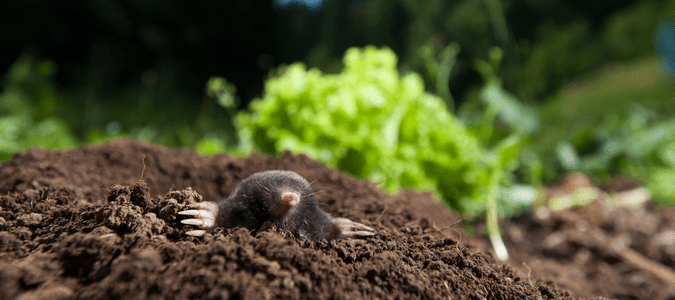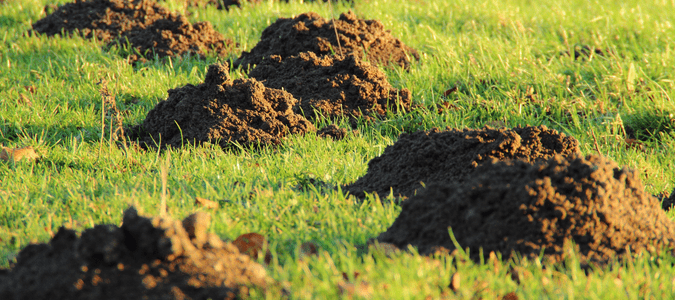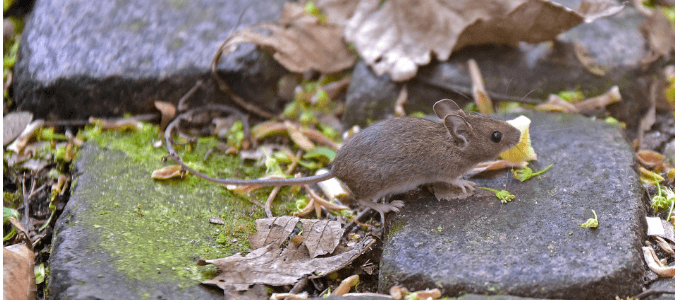Do you know the difference between a mole versus a mouse? While the two animals seem similar, there are key differences that can help homeowners tell them apart.
The first major difference is that, unlike mice, moles are not actually rodents. Other differences between moles and mice include their appearance, habitats, nesting habits and diet.
While it’s common to find mice inside your home or on your property, moles live most of their lives underground. The only time homeowners may see them is when they surface to find a mate.
The more you know about the differences between a mole and a mouse, the easier it is to identify a pest problem. Both moles and mice can cause property damage, so it’s best to catch an infestation early. A pest control specialist can help you identify which animal is causing you problems and provide solutions to kick them off your property.
Mouse Appearance, Habits, Nests and Diet
The first way to distinguish mice from moles is by their appearance. There are over 30 species of mice, so their appearance can vary, while moles have a very distinct look.
However, most mice are between five and seven inches, which includes their tails. Their fur colors include tan, brown, black, brown and gray. Some species also have light-colored underbellies.
Unlike moles, mice have long tails. As you can see in the image above, they also have small beady eyes, large round ears and pointed noses. Moles are known for their big claws, while mice have dainty paws.
Voles are another creature that can be confused with mice. Voles are compact animals with short legs, small eyes and partially hidden ears. Their fur is blackish brown to grayish brown, and long and coarse. Voles are typically 5 to 8 inches long, including their tail. They can also dig up lawns, similar to mice.
The next major difference between a mole versus mouse is their nesting habits. Depending on the species, a mouse population can take up residence on your exterior property and inside your house. And, due to their prolific breeding habits, there are typically many mice in a nest.
Outdoors, mice like to live in forests, alongside streams and swamp lands, on farms and in other grassy habitats. Some also make their homes in big urban cities. Mice make their way indoors to seek shelter, escape from predators and find a new food source.
House mice and deer mice are the most likely species to move indoors for the winter. Family homes make excellent residences for mice because there are plenty of places for them to hide and remain discreet.
Many homeowners don’t discover a mouse infestation until the signs become obvious. Mice are nocturnal creatures, so it’s unlikely to see them moving through the house during the day. However, at night you might hear them scurrying around as they run from their nest to their food source.
Mice build nests in warm, dry and dark places. They like to stay close to their food source, which is why the kitchen is one of the most common places to discover a mouse nest. They might nest behind appliances, in unused cabinets and drawers or inside the pantry.
These unwanted guests use a variety of materials to make their nests. When they nest indoors, they steal whatever they can find that is soft and fibrous. Paper, linens, string and pillow stuffing all make great nesting materials.
Mouse nests are dirty and unsightly. All of their materials are loosely piled together to form a nest, and mice hide their food inside it. They also raise their young pups in the nest and use it as a toilet. One of the most common signs of a mouse infestation is the smell of their urine, which smells like ammonia.
Mice will eat anything they can find; however, they are certain foods they prefer. Contrary to popular belief, cheese is not their favorite food. While mice will eat animal products, they prefer a vegetarian diet. Fruits, vegetables, seeds, nuts and grains are their top choices.
These pests are known for digging into trash and compost bins in search of food. If you suspect that you have a mouse infestation in your home, contact a pest control specialist right away.
Mole’s Appearance, Habits, Nests and Diet
The most obvious way to tell the difference between a mole versus mouse is the fact that moles are much bigger than mice. Moles can reach up to eight inches long, and they do not have tails. Mole fur is dark and satiny.
As you can see in the image above, mole eyes and ears are not visible to the human eye. It’s a common misconception that moles are blind when, in fact, they just have very poor eyesight.
The easiest way to distinguish a mole is by its impressive paws. They have huge front and back feet that are made for digging. Their paws have six fingers, which include two thumbs, and they are extremely sharp.
Moles also prefer very different habitats from mice. Outdoor mice live above ground while moles spend most of their lives underground. They dig their own tunnels, so they care more about the type of terrain they live in than mice.
Moles like soil that is loose and moist to make digging easier. Their tunnels are typically ten inches under the surface.
Unlike mice, moles do not infest homes or buildings. They do not like to be near humans or other potential predators. Moles are extremely territorial and protective of their tunnels. They spend most of their lives alone instead of living in colonies, and they will fight other moles off of their territory.
Moles feed on grubs, earthworms and other insects that they find underground. Since their eyesight is poor, they use their hearing to find their prey.
Since it’s unlikely to see moles, the best way for homeowners to identify moles in their yards is by the property damage they cause. Moles don’t eat plants, but their underground tunnels can disrupt root systems and lead to damage.
Mole tunnels also damage grassy lawns. Displaced dirt and mole holes are common signs of a mole problem. If you’re tired of the mess that moles leave behind in your yard, contact a specialist today.
What Do Mole Holes Look Like?
Moles can create unsightly damage to your yard, especially with their mole holes. The holes are the openings to their underground tunnels. They look like dirt piles shaped like a volcano with a small opening at the top of the soil.
Moles are extremely fast diggers and can move a foot of dirt in under a minute. They become nuisances for homeowners because they are relentless and turn beautifully manicured lawns into messes.
Along with dirt mounds, these pests also create dirt ridges throughout your lawn. The ridges are actually tunnels that are closer to the surface. They look like long dirt runways. If your lawn is being destroyed by mole activity, contact a mole control expert to take care of it.
Do Mice Eat Grass?
Mice are adaptive creatures that will feed on whatever they can get their paws on. Wild mice that live outdoors primarily feed on grass since it’s easy to access. Indoor mice will eat grass that gets tracked into the house; however, they may also have access to other types of foods that they enjoy more, such as nuts, seeds and pet food.
Outdoor mice like to nest in grasslands because they never run out of food. The grass also provides shelter and hides them from predators. If you have tall grass on your property, it gives mice ample opportunity to nest on your property. You can contact a pest control specialist to deal with indoor and outdoor mouse infestations.
If you’re still not sure which type of pest is wreaking havoc on your property, contact a pest control specialist today. Both moles and mice are hard to get rid of without professional support. The experts can make the process smooth and help you kick out your uninvited guests.
ABC Can Identify Your Problem: Mole Versus Mouse
Dealing with a pest problem, whether it’s a mole or mouse, can be overwhelming. Instead of handling these pests on your own, contact ABC Home & Commercial Services. Our licensed professionals will create a customized mole or rodent control plan, so you can feel comfortable at home again.




